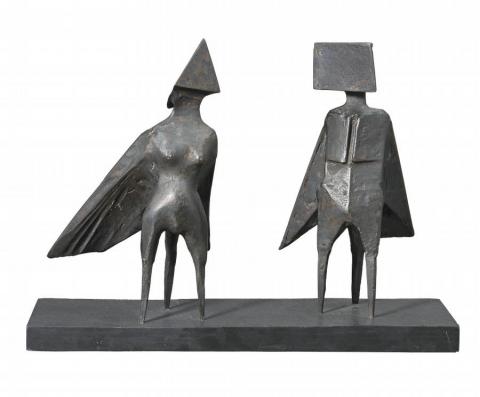MAQUETTE III TWO WINGED FIGURES, 1973
Lynn Chadwick
bronze figures on a slate base
28.5 cm height
edition: 5/6
female figure stamped: C 73 670 5/6 F
male figure stamped: 73 M / 670 5/6 C
Osborne Samuel Gallery, London
Private collection, Sydney
Farr, D. and Chadwick, E., Lynn Chadwick, Sculptor: With a Complete Illustrated Catalogue 1947 – 2005, Lund Humphries, United Kingdom, 2000, cat. 670, p. 296 (illus., another example)
Born in London in 1914, Chadwick studied architectural drafting and design after his World War II service as a Royal Navy pilot, before emerging during the 1950s as a sculptor with a singularly distinctive and dynamic style. Following two solo exhibitions at Gimpel Fils, London, he was invited to exhibit at the British Pavilion of the Venice Biennale in 1952, and in 1956, was awarded the Biennale's highest honour the prestigious international Prize for Sculpture. Over the subsequent decades, Chadwick has exhibited to widespread acclaim in Paris, London, New York and Tokyo and today is represented with works in most major international collections including the Museum of Modern Art, New York; the Tate Gallery, London; the Musée National d'Art Moderne, Paris; and the Art Gallery of New South Wales, Sydney.
Although Chadwick's first creations were - quite appropriately given his flying experience - abstract mobiles and elegant suspended constructions of metal and glass, it is his timeless architectonic forms combining elements of the human, animal and mechanical, such as Maquette III Two Winged Figures, for which he is most widely acclaimed.
Gaining inspiration from the innate geometry present in nature, and drawing on his architectural and design experience, Chadwick's figures are constructed rather than modelled, using a skeletal armature onto which a skin is applied and a surface built up, before casting into the enduring medium of bronze. Capturing the rarefied essence of something human, universal, contemplative and at times elegiac, Chadwick's mysterious work invariably beguiles and attracts. Yet these remarkable figures, in their anonymous strength and silent presence, remain powerfully elusive.
And perhaps that is the point, as the artist himself - notoriously reluctant to assign specific meaning to his work - elaborates, '...The important thing in my figures is always the attitude - what the figures are expressing through their actual stance. I want them to talk, as it were....'1
1. Lynn Chadwick cited in Lucie-Smith, E., Lynn Chadwick, Lypiatt Studio, Gloucestershire, 1997, p. 48
